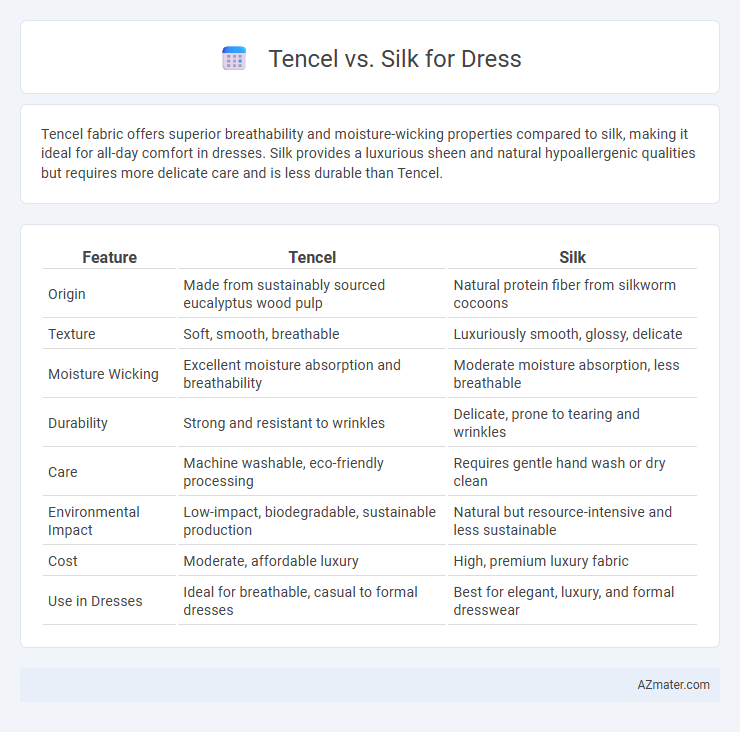Tencel fabric offers superior breathability and moisture-wicking properties compared to silk, making it ideal for all-day comfort in dresses. Silk provides a luxurious sheen and natural hypoallergenic qualities but requires more delicate care and is less durable than Tencel.
Table of Comparison
| Feature | Tencel | Silk |
|---|---|---|
| Origin | Made from sustainably sourced eucalyptus wood pulp | Natural protein fiber from silkworm cocoons |
| Texture | Soft, smooth, breathable | Luxuriously smooth, glossy, delicate |
| Moisture Wicking | Excellent moisture absorption and breathability | Moderate moisture absorption, less breathable |
| Durability | Strong and resistant to wrinkles | Delicate, prone to tearing and wrinkles |
| Care | Machine washable, eco-friendly processing | Requires gentle hand wash or dry clean |
| Environmental Impact | Low-impact, biodegradable, sustainable production | Natural but resource-intensive and less sustainable |
| Cost | Moderate, affordable luxury | High, premium luxury fabric |
| Use in Dresses | Ideal for breathable, casual to formal dresses | Best for elegant, luxury, and formal dresswear |
Introduction to Tencel and Silk Fabrics
Tencel, a sustainable fabric made from eucalyptus wood pulp, offers exceptional breathability and moisture-wicking properties ideal for dresses. Silk, a natural protein fiber produced by silkworms, is renowned for its luxurious texture, sheen, and smooth drape in high-end apparel. Both fabrics provide comfort and elegance, but Tencel's eco-friendly production contrasts with silk's traditional, labor-intensive cultivation.
Origin and Production Processes
Tencel, derived from sustainably sourced eucalyptus wood pulp, undergoes an eco-friendly closed-loop production process that recycles water and solvents, minimizing environmental impact. Silk originates from the silkworm cocoon, produced through the labor-intensive harvesting and reeling of natural protein fibers, often involving traditional sericulture methods. The contrast between Tencel's modern, sustainable technology and silk's ancient, animal-based production highlights distinct ecological and ethical considerations in textile manufacturing.
Texture and Feel: Tencel vs Silk
Tencel fabric offers a smooth, breathable texture with a soft, cool feel ideal for sensitive skin, while silk provides a luxurious, glossy surface that feels exquisitely smooth and lightweight against the skin. The moisture-wicking properties of Tencel make it more temperature-regulating and less prone to clinginess compared to silk, which can feel warmer and more delicate. Both fabrics excel in softness, but Tencel's sustainable fiber produces a matte finish, contrasting with silk's natural sheen and slippery touch.
Breathability and Comfort in Dresses
Tencel offers superior breathability due to its moisture-wicking cellulose fibers, making it ideal for dresses worn in warm or humid climates. Silk provides a smooth, luxurious feel but is less effective at moisture management, which can lead to discomfort in hot weather. Dresses made from Tencel promote better airflow and temperature regulation, enhancing all-day comfort compared to silk.
Sustainability and Eco-Friendliness
Tencel, derived from sustainably managed eucalyptus trees, offers superior biodegradability and a lower environmental footprint compared to silk, which involves energy-intensive sericulture and often raises animal welfare concerns. The closed-loop production process of Tencel minimizes water and chemical usage, making it a more eco-friendly choice for dress materials. While silk is prized for its luxurious texture, Tencel's sustainable production and recyclable nature position it as a leading option for environmentally conscious fashion.
Durability and Care Requirements
Tencel fabric offers superior durability compared to silk, resisting wear and tear while maintaining its softness after multiple washes. Silk, though luxurious and smooth, requires delicate handling, hand washing or dry cleaning, and is prone to snagging and weakening over time. Care for Tencel is easier and more forgiving, making it ideal for everyday dresses that need both comfort and longevity.
Drapability and Aesthetic Appeal
Tencel offers exceptional drapability with a smooth, fluid texture that enhances the silhouette of dresses, making it ideal for flowing, elegant designs. Silk is renowned for its luxurious sheen and natural elasticity, providing exquisite drapability that creates a graceful and sophisticated aesthetic appeal. Both fibers deliver high-end looks, but Tencel's eco-friendly production and moisture-wicking properties give it modern functional advantages over traditional silk.
Price Comparison: Tencel vs Silk
Tencel dresses generally cost significantly less than silk dresses, making them a more budget-friendly option for quality fabric. While silk prices vary widely based on grade and origin, they are typically higher due to labor-intensive production and luxurious appeal. Tencel offers affordable softness and durability with a price range roughly 30-70% lower than comparable silk garments.
Suitability for Different Dress Styles
Tencel fabric offers excellent breathability and moisture-wicking properties ideal for casual and flowy dress styles, providing a soft drape and comfort in warmer climates. Silk excels in formal and elegant dress designs due to its luxurious sheen and smooth texture, enhancing structured silhouettes and evening wear with a sophisticated finish. Both fabrics provide versatility, but Tencel suits relaxed, everyday dresses while silk is preferred for high-end, special occasion garments.
Final Verdict: Choosing the Right Fabric
Tencel offers breathability, moisture-wicking, and eco-friendly production, making it ideal for comfortable, sustainable dresses. Silk provides a luxurious texture, natural sheen, and excellent drape, perfect for formal or elegant occasions. Selecting the right fabric depends on prioritizing sustainability and comfort with Tencel or opting for classic elegance and smoothness with silk.

Infographic: Tencel vs Silk for Dress
 azmater.com
azmater.com